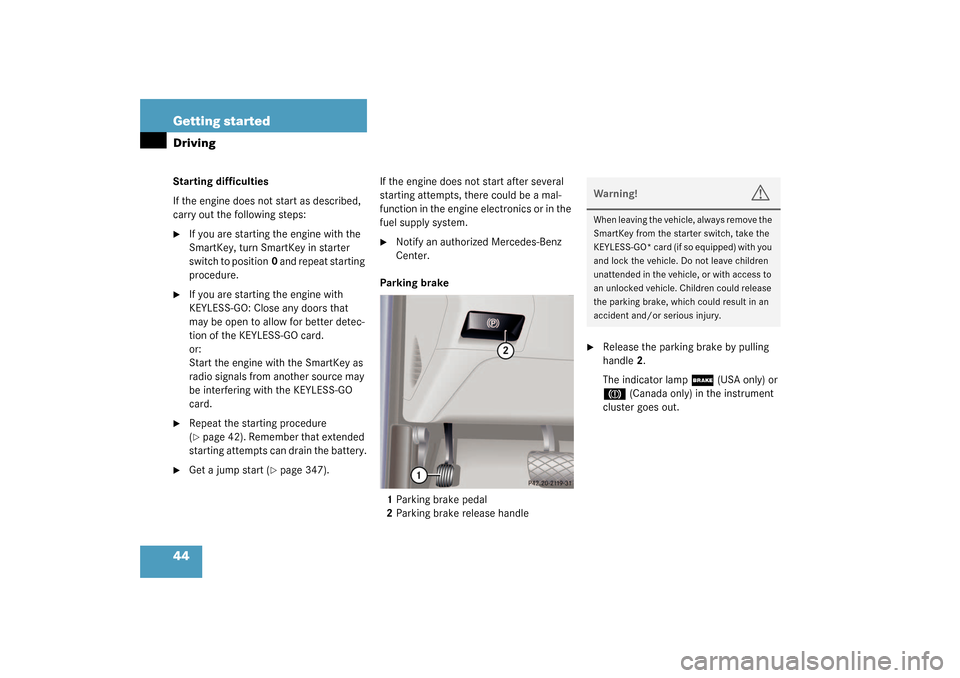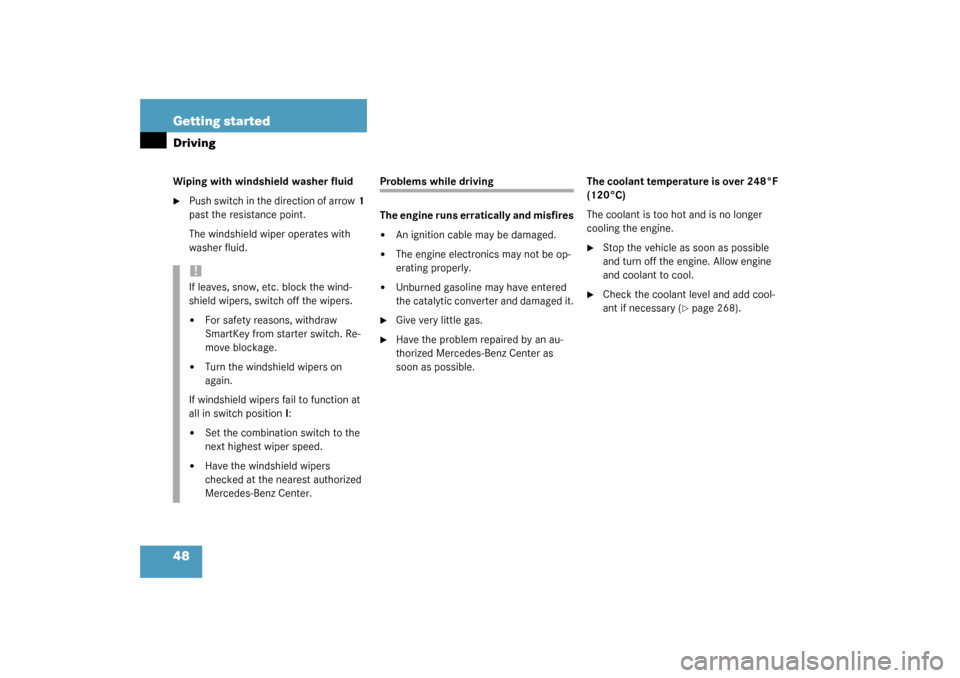Page 36 of 416

36 Getting startedAdjusting�
Turn the SmartKey in the starter switch
to position1or2.
or
�
Press the KEYLESS GO* start/stop
button once or twice.
or
�
Open the respective driver’s or passen-
ger door.
Seat height
�
Press the switch up or down in the di-
rection of arrow2.
Seat cushion tilt
�
Press the switch up or down in the di-
rection of arrow3 until your upper legs
are lightly supported.Seat cushion depth
�
Press the switch forward or backward
in the direction of arrow4 until your
legs are supported comfortably.
Seat fore and aft adjustment
�
Press the switch forward or backward
in the direction of arrow5.
Adjust to a comfortable seating posi-
tion that still allows you to reach the
accelerator / brake pedal safely. The
position should be as far to the rear as
possible, consistent with ability to
properly operate controls.Seat backrest tilt
�
Press the switch forward or backward
in the direction of arrow6 until your
arms are slightly angled when holding
the steering wheel.
iWhen moving the seat, be sure that
there are no items in the footwell or be-
hind the seats. Otherwise you could
damage the seats.
Page 37 of 416

37 Getting started
Adjusting
Head restraint height�
Press the switch up or down in the di-
rection of arrow1.
Head restraint tilt
�
Manually adjust the angle of the head
restraint. Push or pull on the lower
edge of the head restraint cushion.
For more information, see “Front seat head
restraints” (
�page 105).
Steering wheel
Warning!
G
For your protection, drive only with properly
positioned head restraints.
Adjust head restraint to support the back of
the head approximately at ear level.
Do not drive the vehicle without the seat
head restraints. Head restraints are intend-
ed to help reduce injuries during an acci-
dent.
iThe front passenger seat head restraint
automatically lowers after a few sec-
onds when the front passenger seat is
not occupied. This improves the driv-
er’s outward view as well as the for-
ward view from the rear passenger
compartment.
When the front passenger seat is occu-
pied again, the front passenger seat
head restraint returns to the last set
position within a few seconds.
If the front passenger seat was moved
fore or aft while not being occupied,
the front passenger seat head restraint
returns to a position that corresponds
best with the seat’s axial position when
the seat is occupied again.
Warning!
G
Do not adjust the steering wheel while driv-
ing. Adjusting the steering wheel while driv-
ing could cause the driver to lose control of
the vehicle.
When leaving the vehicle, always remove the
SmartKey from the starter switch, and take
the KEYLESS-GO
* card (if so equipped) with
you.
The steering wheel adjustment feature can
also be operated with the driver’s door
open. Do not leave children unattended in
the vehicle, or with access to an unlocked
vehicle. Unsupervised use of vehicle equip-
ment may cause an accident and/or serious
personal injury.
Page 38 of 416

38 Getting startedAdjustingSteering wheel adjustment
The stalk is located on the steering column
(lower left).
1Steering column, lengthen or shorten
2Steering column, height�
Turn the SmartKey in the starter switch
to position1or2.
or
�
Press the KEYLESS GO* start/stop
button once or twice.
or
�
Open the driver’s or passenger door.Steering column, lengthen or shorten
�
Move stalk forward or backward in the
direction of arrows1 until a comfort-
able steering wheel position is reached
with your arms slightly bent at the el-
bow.
Steering column, height
�
Move the stalk up or down in the direc-
tion of arrows2. Make sure that your
legs can move freely and that all of the
displays (including malfunction and in-
dicator lamps) on the instrument clus-
ter are clearly visible.
Mirrors
Adjust the inside and exterior rear view
mirrors before driving so that you have a
good view of the road and traffic condi-
tions.
Inside rear view mirror�
Manually adjust the inside rear view
mirror.Warning!
G
In the case of an accident liquid electrolyte
may escape the mirror housing if the mirror
glass breaks.
Electrolyte has an irritating effect. Do not al-
low the liquid to come into contact with
eyes, skin, clothing, or respiratory system.
In case it does, immediately flush affected
area with water, and seek medical help if
necessary.
Page 43 of 416

43 Getting started
Driving
Automatic transmissionGearshift pattern for automatic
transmissionPPark position with selector lever lock
RReverse gear
NNeutral
DDrive position�
Make sure that the gear selector lever
is set toP.Starting with the SmartKey
�
Turn the SmartKey in the starter switch
to position3 and hold until the engine
starts (
�page 31).
�
Firmly depress the brake pedal.
The selector lever lock is released.
For information on turning off the engine
with the SmartKey, see “Turning off engine
with the SmartKey” (
�page 52).
Starting with KEYLESS-GO*
You can start your vehicle without a
SmartKey using the KEYLESS-GO
start/stop button on the gear selector le-
ver.1KEYLESS-GO start/stop button
�
Firmly depress the brake pedal during
the starting procedure. Do not depress
accelerator.
The selector lever lock is released.
�
Press KEYLESS-GO start/stop
button1 once.
The engine starts automatically.
For information on turning off the engine
with KEYLESS-GO, see “Turning off engine
with KEYLESS-GO*” (
�page 53).
iYou can also use the “touch-start”
function. Turn the SmartKey to
position3 and release it again immedi-
ately. The engine then starts automati-
cally.
Page 44 of 416

44 Getting startedDrivingStarting difficulties
If the engine does not start as described,
carry out the following steps:�
If you are starting the engine with the
SmartKey, turn SmartKey in starter
switch to position0 and repeat starting
procedure.
�
If you are starting the engine with
KEYLESS-GO: Close any doors that
may be open to allow for better detec-
tion of the KEYLESS-GO card.
or:
Start the engine with the SmartKey as
radio signals from another source may
be interfering with the KEYLESS-GO
card.
�
Repeat the starting procedure
(�page 42). Remember that extended
starting attempts can drain the battery.
�
Get a jump start (
�page 347).If the engine does not start after several
starting attempts, there could be a mal-
function in the engine electronics or in the
fuel supply system.
�
Notify an authorized Mercedes-Benz
Center.
Parking brake
1Parking brake pedal
2Parking brake release handle
�
Release the parking brake by pulling
handle2.
The indicator lamp
;
(USA only) or
3
(Canada only) in the instrument
cluster goes out.
Warning!
G
When leaving the vehicle, always remove the
SmartKey from the starter switch, take the
KEYLESS-GO* card (if so equipped) with you
and lock the vehicle. Do not leave children
unattended in the vehicle, or with access to
an unlocked vehicle. Children could release
the parking brake, which could result in an
accident and/or serious injury.
Page 48 of 416

48 Getting startedDrivingWiping with windshield washer fluid�
Push switch in the direction of arrow1
past the resistance point.
The windshield wiper operates with
washer fluid.
Problems while driving
The engine runs erratically and misfires�
An ignition cable may be damaged.
�
The engine electronics may not be op-
erating properly.
�
Unburned gasoline may have entered
the catalytic converter and damaged it.
�
Give very little gas.
�
Have the problem repaired by an au-
thorized Mercedes-Benz Center as
soon as possible.The coolant temperature is over 248°F
(120°C)
The coolant is too hot and is no longer
cooling the engine.
�
Stop the vehicle as soon as possible
and turn off the engine. Allow engine
and coolant to cool.
�
Check the coolant level and add cool-
ant if necessary (
�page 268).
!If leaves, snow, etc. block the wind-
shield wipers, switch off the wipers.�
For safety reasons, withdraw
SmartKey from starter switch. Re-
move blockage.
�
Turn the windshield wipers on
again.
If windshield wipers fail to function at
all in switch positionI:
�
Set the combination switch to the
next highest wiper speed.
�
Have the windshield wipers
checked at the nearest authorized
Mercedes-Benz Center.
Page 50 of 416

50 Getting startedParking and locking
Parking and lockingYou have now completed your first drive.
You have properly stopped and parked
your vehicle. End your drive as follows.
Parking brake
1Parking brake
2Release handle�
Step firmly on parking brake1.
When the engine is running, the
indicator lamp
;
(USA only) or
3
(Canada only) in the instrument
cluster illuminates.
Warning!
G
Wait until the vehicle is stationary before re-
moving the SmartKey from the starter
switch. The vehicle cannot be steered when
the SmartKey is removed.Warning!
G
With the engine not running, there is no
power assistance for the brake and steering
systems. In this case, it is important to keep
in mind that a considerably higher degree of
effort is necessary to brake or steer the ve-
hicle.
Warning!
G
Do not park this vehicle in areas where com-
bustible materials such as grass, hay, or
leaves can come into contact with the hot
exhaust system, as these materials could be
ignited and cause a vehicle fire.
To reduce the risk of personal injury as a re-
sult of vehicle movement, before turning off
the engine and leaving the vehicle always:�
Keep right foot on brake pedal.
�
Firmly depress parking brake pedal.
�
Move the selector lever to positionP.
�
Slowly release brake pedal.
�
When parked on an incline, turn front
wheel towards the road curb.
�
Turn the SmartKey to starter switch
position0 and remove, or press
start- / stop button (vehicles with KEY-
LESS-GO*).
�
Take the SmartKey or the KEYLESS-GO*
card (if so equipped) and lock vehicle
when leaving.
Page 51 of 416
51 Getting started
Parking and locking
Switching off headlamps�
Turn the exterior lamp switch to
M
.
For more information, see “Lighting”
(
�page 120).
Warning!
G
When leaving the vehicle, always remove the
SmartKey from the starter switch, take the
KEYLESS-GO* card (if so equipped) with you
and lock the vehicle. Do not leave children
unattended in the vehicle, or with access to
an unlocked vehicle. Children could release
the parking brake and/or move the gear se-
lector lever from positionP, either of which
could result in an accident and/or serious
injury.
Warning!
G
Getting out of your vehicle with the selector
lever not fully engaged in positionP is dan-
gerous. Also, when parked on an incline,
positionP alone may not prevent your vehi-
cle from moving, possibly hitting people or
objects.
Always set the parking brake in addition to
shifting to positionP (
�page 162).
When parked on an incline, turn front wheels
towards the road curb.